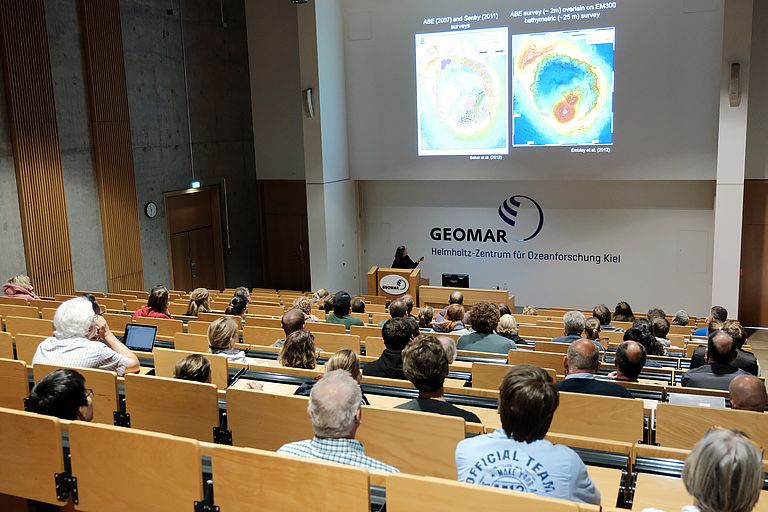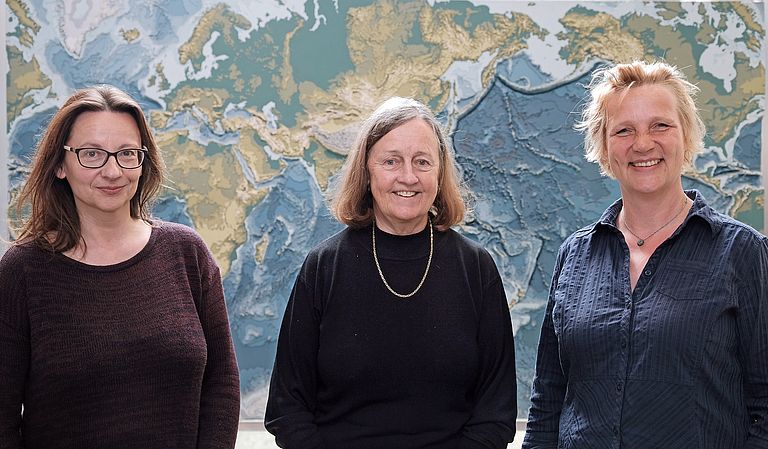The Interplay between Magmatic, Tectonic and Hydrothermal Processes at Oceanic Plate Margins
26th Marie-Tharp Lecture with Dr. Susan Humphris from the Woods Hole Oceanographic Institution
25 April 2019/Kiel. Along the margins of oceanic plates, hot vents occur on ocean floors. These so-called hydrothermal systems were only discovered in the 1970s. Since then, they have fascinated scientists because they are home to unique ecosystems, they form mineral deposits and they provide insights into the structure of the seabed and the processes that take place inside it. Since the discovery of hot hydrothermal vents on the seafloor forty years ago, great advances have been made in the understanding of underground saltwater-rock reactions and the formation of marine ore deposits associated with hydrothermal processes.
During the 26th Marie-Tharp Lecture, Dr. Susan Humphris from the Woods Hole Oceanographic Institution yesterday presented a summary of the latest research results on the interaction of magmatic, tectonic and hydrothermal processes to the expert audience at the GEOMAR Helmholtz Centre for Ocean Research Kiel. In the course of her career, Dr. Humphris herself has contributed significantly to the progress in this research topic.
Dr. Humphris presented several examples of seafloor hydrothermal systems that illustrate the variable connections between magmatic, volcanic, and tectonic processes: hydrothermal convection within the oceanic basement; and the chemistry of discharging hydrothermal fluids and mineral deposits. Along fast-spreading mid-ocean ridges, such as the East Pacific Rise, robust magma supplies result in extension being mostly accommodated by magmatism. Hydrothermal convection is driven by heat from axial magma lenses at shallow depths, which limits the depths of fluid circulation.
As spreading rate decreases, faulting with only intermittent volcanic activity accommodates a significant portion of the extension. Fluids are focused along large faults and can reach much greater depths, such as at the TAG hydrothermal field on the Mid-Atlantic Ridge. In convergent margin settings, such as at Brothers submarine arc volcano, fluids react with more felsic rocks, and magmatic degassing significantly impacts the chemistry of circulating fluids and the nature of seafloor mineral deposits. This interplay between magmatic, tectonic and hydrothermal processes facilitates the cycling of heat and mass between the Earth and the oceans.
Dr. Susan Humphris studied environmental science at the University of Lancaster and earned her PhD degree in 1977 through the MIT/WHOI Joint-Program in chemical oceanography. After a short PostDoc research stint at Imperial College in London, she returned to WHOI in 1978, where she holds a Senior Scientist position since 1998 and where she served as the Chair of the Geology and Geophysics Department between 2004-2008. Dr. Humphris is an AGU Fellow and held a number of chair positions within her career, i.e. the External Advisory Board, C-DEBI (NSF Science and Technology Center, U. Southern California), the JOIDES Resolution Facility Board, the Maurice Ewing Medal Committee, ODP Performance Evaluation Committee, etc. Currently Dr. Humphris is a member of the Scientific Advisory Board of GEOMAR.
The "Marie-Tharp Lecture Series" is hosted by the Women's Executive Board (WEB) of GEOMAR. The WEB invites internationally renowned female scientists who present their scientific work in Kiel, but at the same time serve as role models for young female scientists. As for previous lectures, after the public lecture, a get-together took place only for female scientists. There, young female researchers exchanged ideas with more experienced female colleagues and discussed possible career paths.




